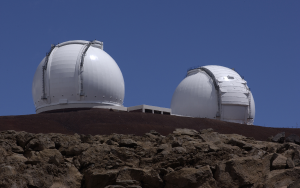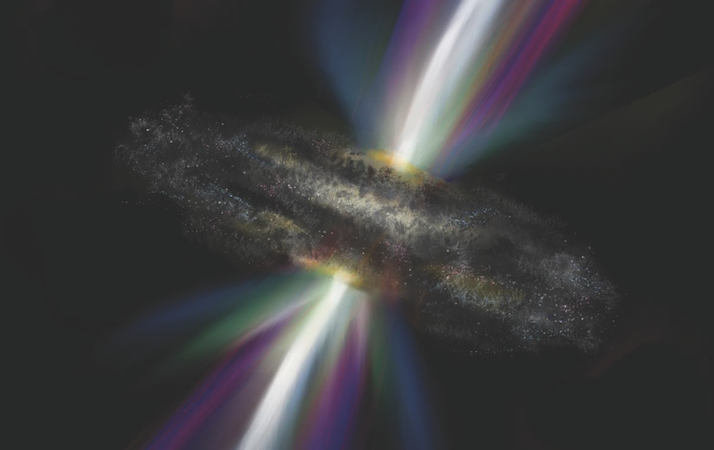A long, long time ago in a galaxy far, far away…
Specifically, more than 12 billion years ago in a galaxy called CID-947, one of the largest black holes discovered to date was formed.
While working on a project to map out ancient moderate- to massive-sized black holes, a team of international researchers stumbled across an unusual supermassive black hole (SMBH). This group included Yale University’s Meg Urry, an Israel Munson professor of astrophysics. Upon closer investigation, the team was surprised to learn that certain qualities of the black hole seem to challenge widely accepted theories about the formation of galaxies.
The astrophysical theory of co-evolution suggests that galaxies pre-date their black holes. But certain characteristics of the supermassive black hole located in CID-947 do not fit this timeline. As Urry put it: “If this object is representative [of the evolution of galaxies], it shows that black holes grow before their galaxies — backwards from what the standard picture says.”
The researchers published their remarkable findings in July in the journal Science. Not only was this an important paper for astrophysicists everywhere, but it also reinforced the mysterious nature of black holes. Much remains unknown about galaxies, black holes, and their place in the history of the universe — current theories may not be sufficient to explain new observations.

The ordinary and the supermassive
Contrary to what their name might suggest, black holes are not giant expanses of empty space. They are physical objects that create a gravitational field so strong that nothing, not even light, can escape. As explained by Einstein’s theory of relativity, black holes can bend the fabric of space and time.
An ordinary black hole forms when a star reaches the end of its life cycles and collapses inward — this sparks a burst of growth for the black hole as it absorbs surrounding masses. Supermassive black holes, on the other hand, are too large to be formed by a single star alone. There are two prevailing theories regarding their formation: They form when two black holes combine during a merging of galaxies, or they are generated from a cluster of stars in the early universe.
If black holes trap light, the logical question that follows is how astrophysicists can even find them. The answer: they find them indirectly. Black holes are so massive that light around them behaves in characteristic, detectable ways. When orbiting masses are caught in the black hole’s gravitational field, they accelerate so rapidly that they emit large amounts of radiation — mainly X-ray flares — that can be detected by special telescopes. This radiation appears as a large, luminous circle known as the accretion disc around the center of the black hole. Active galactic nuclei are black holes that are actively forming, and they show a high concentration of circulating mass in their accretion discs, which in turn emits high concentrations of light.
The faster a black hole is growing, the brighter the accretion disc. With this principle in mind, astrophysicists can collect relevant information about black holes, such as their size and speed of formation.
The theory of co-evolution
Nearly all known galaxies have at their center a moderate to supermassive black hole. In the mid-1990s, researchers began to notice that these central black holes tended to relate to the size and shape of their host galaxies. Astrophysicists proposed that galaxies and supermassive black holes evolve together, each one determining the size of the other. This idea, known as the theory of co-evolution, became widely accepted just over a decade ago.
In an attempt to explain the underlying process, theoretical physicists have proposed that there are three distinct phases of co-evolution: the “Starburst Period,” when the galaxy expands, the “SMBH Prime Period,” when the black hole expands, and the “Quiescent Elliptical Galaxy,” when the masses of both the galaxy and the black hole stabilize and stop growing.
The supermassive black hole at the center of the galaxy CID-947 weighs in at seven billion solar masses — seven billion times the size of our sun (which, for reference, is 109 times the size of the earth). But beyond its enormous size, what makes this black hole so remarkable are the size and character of the galaxy that surrounds it.
Current data from surveys observing galaxies across the universe indicate that the total mass distributes between the black hole and the galaxy in an approximate ratio of 2:1000, called the Magorrian relation. A typical supermassive black hole is about 0.2 percent of the mass of its host galaxy. Based on this mathematical relationship, the theory of co-evolution predicts that the CID-947 galaxy would be one of the largest galaxies ever discovered, but in reality CID-947 is quite ordinary in size. This system does not come close to conforming to the Magorrian relation, as the central black hole is a startling 10 percent of the mass of the galaxy.

An additional piece of the theory of co-evolution is that the growth of the supermassive black hole prevents star formation. Stars form when extremely cold gas clusters together, and the resultant high pressure causes an outward explosion, or a supernova. But when a supermassive black hole is growing, the energy from radiation creates a tremendous amount of heat — something that should interrupt star formation.
Here, CID-947 once again defies expectations. Despite its extraordinary size, the supermassive black hole did not curtail the creation of new stars. Astrophysicists clearly observed radiation signatures consistent with star formation in the spectra captured at the W.M. Keck Observatory in Hawaii.
The discovery of the CID-947 supermassive black hole calls into question the foundations of the theory of co-evolution. That stars are still forming indicates that the galaxy is still growing, which means CID-947 could eventually reach a size in accordance with the Magorrian relation. Even so, the evolution of this galaxy still contradicts the theory of co-evolution, which states that the growth of the galaxy precedes and therefore dictates the growth of its central black hole.
New frontiers in astrophysics
Astrophysicists are used to looking back in time. The images in a telescope are formed by light emitted long before the moment of observation, which means the observer views events that occurred millions or even billions of years in the past. To see galaxies as they were at early epochs, you would have to observe them at great distances, since the light we see today has traveled billions of years, and was thus emitted billions of years ago.
The team of astrophysicists that discovered the CID-947 black hole was observing for two nights at the Keck telescope in order to measure supermassive black holes in active galaxies as they existed some 12 billion years ago. The researchers did not expect to find large black holes, which are rare for this distance in space and time. Where they do exist, they usually belong to active galactic nuclei that are extremely bright.
But of course the observers noticed the CID-947 supermassive black hole, which is comparable in size to the largest black holes in the local universe. Its low luminosity indicates that it is growing quite slowly.
“Most black holes grow with low accretion rates such that they gain mass slowly. To have this big a black hole this early in the universe means it had to grow very rapidly at some earlier point,” Urry said. In fact, if it had been growing at the observed rate, a black hole this size would have to be older than the universe itself.
What do these contradictions mean for the field of astrophysics? Urry and her colleagues suggest that if CID-947 does in fact grow to meet the Magorrian relation relative to its supermassive black hole, this ancient galaxy could be a model for the precursors of some of the most massive galaxies in the universe, such as NGC 1277 of the Perseus constellation. Moreover, this research opens doors to better understanding black holes, galaxies, and the universe.
About the Author: Jessica Schmerler is a junior in Jonathan Edwards College majoring in molecular, cellular & developmental biology. She is a member of the Yale Journalism Initiative, a freelance writer for Scientific American MIND magazine, and contributes to several on-campus publications.
Acknowledgements: The author would like to thank Professor Urry for her time and enthusiasm about this fascinating discovery.
Further Reading: Trakhtenbrot, B., Urry, C., et al. 2015. “An over-massive black hole in a typical star-forming galaxy, 2 billion years after the Big Bang.” Science 349 (6244):168-171. DOI:10.1126/science.aaa4506
Cover Image: Art by Ashlyn Oakes.

